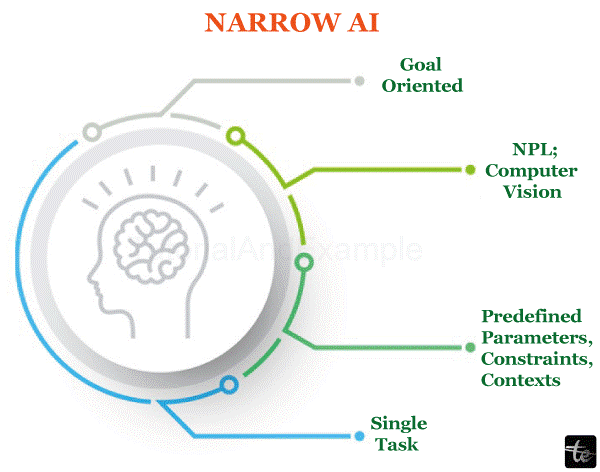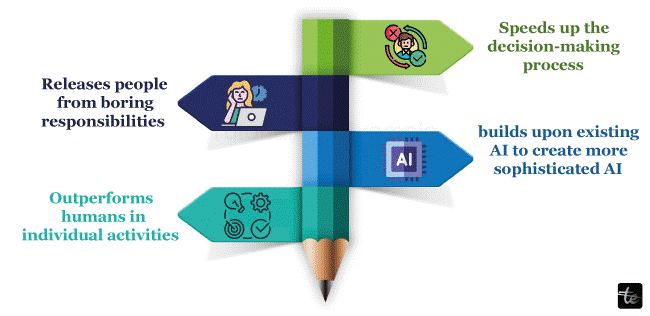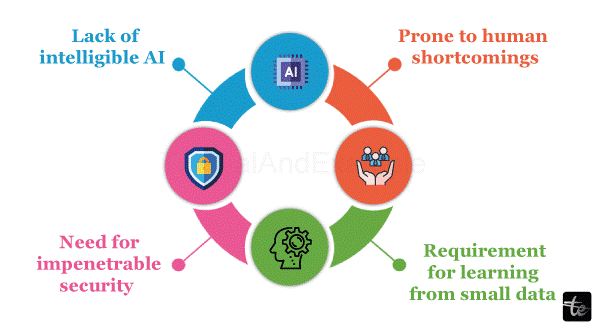Narrow Artificial Intelligence
Introduction:
Artificial narrow intelligence, or ANI, is the goal-oriented kind of AI better suited for a specific activity, such as playing games like chess or poker, watching weather updates, or creating data science reports by evaluating unprocessed data. The foundations of narrow AI, as well as its main benefits and drawbacks, are covered in this article along with the top ten best practices for developing narrow AI.
What is Narrow Artificial Intelligence?
The term "Narrow AI" refers to Artificial Narrow Intelligence (ANI), which is specially designed to be excellent at completing single tasks like data processing, chess playing, and weather tracking. ANI is neither self-aware nor capable of acting intelligently in ways other than those assigned; in contrast to General AI.
Virtual assistants that can comprehend and react to human language within predetermined bounds, such as Siri and Google Assistant, are listed among the criteria of ANI. They are unable to comprehend abstract ideas, though, or think on their own. Even sophisticated systems that rely on pre-established algorithms, such as self-driving vehicles, to traverse their environment, function on narrow artificial intelligence. An artificial narrow intelligence (ANI) system lacks the cognitive flexibility of a person, even if it can function effectively in its designated environment.

By gathering data from a particular dataset, artificial narrow intelligence systems are designed to focus on a single job at a time. To put it another way, these systems only carry out the designated job.
Narrow AI, in contrast to general AI, is devoid of emotions, consciousness, self-awareness, and true intellect comparable to that of humans. Even though these systems have an intelligent and sophisticated appearance, they are limited by specified settings and limitations. That limited AI includes the machine intelligence we see around us now. Some examples of natural language processing tools are Siri, Google Translate, Google Assistant, and others. Weak AI refers to these tools' inability to think independently like humans do, despite the fact that they are capable of interacting with us and processing and understanding human language.
Now let's talk about Siri. It is not an intelligent device. Rather, it is just a tool that does things. During our conversations, Siri interprets our natural language, feeds it into the system's Google-like search engine, and returns results. When someone asks technologies like Alexa or Google Assistant abstract things like how to handle a personal problem or deal with a terrible event, they either respond with nonsensical, ambiguous answers or send them to online articles that ostensibly address the topic at hand. Conversely, when we ask basic questions like "What's the temperature outside? " virtual assistants like Siri usually respond with an appropriate answer. This is so that it can respond to such simple inquiries, which fall within the purview of Siri's intellect.
Furthermore, since self-driving cars are taught to navigate their surroundings using an annotated driving dataset, even anything as sophisticated as them is classified as poor artificial intelligence. Several ANI systems are included in a typical self-driving car, and they are essential to the vehicle's seamless navigation in a very complicated metropolitan setting.
Why is AI Narrow?
ANI stands for Artificial Narrow Intelligence, which is often referred to as narrow or weak AI. We have been able to effectively realize and execute that specific form of AI up to this point. It is a narrowly focused, goal-oriented perspective that is unable to self-expand (functionality). Instead, it conducts specified, targeted activities. Single-tasking machines function under a limited set of constraints and limitations; this is why they are sometimes called WEAK AI. Narrow artificial intelligence essentially copies or simulates human behavior based on a limited set of characteristics; it cannot fully reproduce human intellect.
Over the past few decades, advances in machine learning and deep learning have brought about many ups and downs for narrow artificial intelligence. Narrow artificial intelligence (AI) is a mix of two terms: artificial intelligence (AI) refers to the technology that uses a set of algorithms to replicate human behavior in computers, and narrow AI implies applying the idea of AI to a limited set of tasks.
Natural Language Processing (NLP) is the fundamental idea behind narrow artificial intelligence (AI) machine intelligence. The NLP idea is a prevalent feature of chatbots and related artificial intelligence fields, wherein computers are essentially taught to communicate with people using voice and text recognition mechanisms.
Different types of Narrow AI:
There are two types of narrow artificial intelligence: reactive AI and restricted AI.
Reactive AI:
It is the entry-level model, with no data storage or memory. It mimics the way the human mind works and reacts to many interpretations without any prior knowledge.
AI with limited memory:
It is more sophisticated, with excellent memory and data storage capacities that allow machines to properly understand information by employing statistical data. The majority of AI is limited memory AI, which allows computers to exploit vast amounts of data, particularly in the Deep Learning domains, to produce extremely accurate results.
Narrow AI Examples:
- Virtual assistants such as Microsoft Cortana, Amazon Alexa, Apple Siri, etc.
- Used in drugs and prediction tools to provide incredibly accurate diagnoses of cancer and other health-related conditions using human behavior cognition, replication, and reasoning.
- Watson from IBM: It can respond to inquiries in natural language interpretations.
- Autonomous Vehicles.
- software for facial and image recognition and interpretation.
- Email spam filters and social media marketing tools for monitoring illegal material.
- Robots for manufacturing and drone use.
- Tools for displaying the top suggestions in the marketing and entertainment sectors based on searches, purchases, past usage, etc.
Advantages of Narrow AI:

1. Speeds up the decision-making process
Artificial intelligence systems with limited intelligence may make decisions more quickly because they analyze information and do tasks much faster than humans. They therefore enable us to increase general production and efficiency, which in turn raises our standard of living. By utilizing artificial intelligence (AI), for instance, artificial narrow intelligence systems like IBM's Watson help physicians make prompt, data-driven judgments. The healthcare system is now safer, more efficient, and better than it was previously.
2. Releases people from boring responsibilities
Narrow AI developments have made it possible for people to be freed from some boring, repetitive, and menial activities. From lowering the work required to analyze vast amounts of data to getting results to enable us to buy food online with Siri's assistance, technology has made our daily lives simpler.
Technologies like self-driving vehicles have also given us more free time to engage in our hobbies and activities rather than adding to the stress and strain of being delayed in traffic for extended periods.
3. Builds upon existing AI to create more sophisticated AI
The development of artificial limited intelligence systems paves the way for the ultimate creation of more sophisticated AI variants, including general and super AI. Computer vision allows objects in video streams to be recognized and classified, while speech recognition allows computers to turn sounds into text with a high degree of accuracy. Google currently captions millions of YouTube videos with artificial intelligence.
Computer vision driven by AI is already being used to unlock displays and tag pals online. Meanwhile, the autonomous vehicle industry is delving into "affective AI," a discipline in which a system is trained to recognize nonverbal cues (such as sentiments and emotions) and may awaken tired truck drivers by reminding them to pay attention and remain awake. Future iterations of AI that are aware of themselves and their surroundings are only being made possible by these core technologies.
4. Outperforms humans in individual activities
Narrow AI systems are significantly more efficient than humans at doing certain jobs. When compared to a qualified radiologist, a limited AI system trained to identify cancer from X-ray or ultrasound pictures might be able to identify a malignant growth in a series of photos far more swiftly and accurately.
Predictive maintenance systems employed in manufacturing facilities provide still another illustration. The system determines whether a machine is going to malfunction by gathering and analyzing incoming sensor data in real time. This task is automated by narrow AI. The entire process is substantially faster, and in terms of accuracy and speed, it is nearly hard for a person or group of individuals to equal.
Narrow AI outperforms humans in terms of total performance, speed, and accuracy. Having said that, expanding the application of specific AI presents the AI community with some formidable obstacles.
Challenges of Narrow AI:

- Lack of intelligible AI:
Making AI less of a black box is one of the fundamental criteria for the advancement of artificial intelligence. This suggests that to comprehend what is occurring in neural networks, we need to be in a better position. Modern AI systems, like one that suggests books to read, use the black-box technique well. In these situations, a deep learning algorithm analyzes millions of data points as inputs and connects particular properties to provide a conclusion. Programmers and subject matter specialists find it difficult to understand the self-directed nature of the underlying process.
- Need for impenetrable security:
Neural networks are heavily utilized by narrow artificial intelligence (AI). However, it's important to realize that AI is very delicate—it's possible to introduce noise and trick the system. For instance, an attacker can hack into the software system of autonomous cars and alter the code of the AI program so that the program may mistake a bus on the road for an elephant. This can have serious repercussions. Moreover, a hacker can hijack the entire network of autonomous vehicles operating in an area and eventually wipe out a billion-dollar investment. Moreover, a single intrusion into a neural network can disrupt the operations of multiple systems dependent on that same network. Finally, since neural networks are vulnerable to attacks, providing impenetrable security.
- Requirement for learning from small data:
AI must be able to learn more from less data to advance. It must be able to transfer its learning from one neural network to another by utilizing prior knowledge. AI combines learning and reasoning. While current AI has made great strides in learning and accumulating knowledge, applying reason to that knowledge remains a challenge. For instance, a retailer's customer service chatbot could respond to inquiries about store hours, product prices, and cancellation policies. In other words, examples are the real currency when it comes to AI today.
- Prone to human shortcomings:
Narrow AI is mostly task-oriented and depends on humans. Because of this, it is vulnerable to human error, such as when someone sets too high goals for their company or prioritizes jobs improperly.
Imagine if a task is incorrectly defined by a person. In this scenario, a machine's final result will always be false, regardless of how long it operates or how many calculations it completes. Thus, professionals in the field have a great deal of difficulty due to narrow AI's dependence on human fallibility.
Conclusion:
The cognitive range and flexibility of General AI are superior to Narrow Artificial Intelligence (ANI), which is superior at certain tasks. It revolutionizes industries like manufacturing and healthcare with its substantial advantages including increased efficiency and speed of decision-making. On the other hand, obstacles to its broad acceptance and development include issues with interpretability, security flaws, and dependence on human-defined specifications. The resolution of these issues is imperative to optimize AI's potential and minimize its hazards as it develops further.